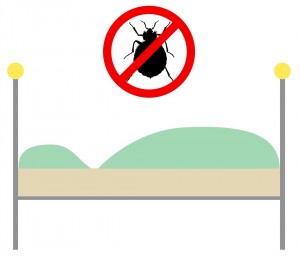The Chattanooga Times Free Press reported over the weekend of a large apartment building that is experiencing large scale problems with bed bugs.
To one resident who moved in after the summer mayhem, though, plenty of issues remain and humanitarian-type issues like the creepy critters are first and foremost.
“The bedbugs are still present [and] residents are told they have to get rid of their furniture and many have been forced to do this and are left with nothing, sleeping on the floor with no beds or furniture,” wrote one man who asked to remain anonymous because he fears eviction.
Living in an apartment or condo unit provides its own complications to avoid an infestation of bed bugs. Often times a bed bug problem can arise not because of anything you have done, but through actions by another tenant or introduction by a worker at the living facility.
 So how can you best prevent yourself from getting bed bugs in apartment or group living space?
So how can you best prevent yourself from getting bed bugs in apartment or group living space?
The solution for a bed bug problem can be quite complicated and difficult at times because it is not you who control all the aspects of the living space (unless you are the property manager). But there are best practices to help keep bed bugs from infesting your apartment. Should you get an infestation these best practices will help to keep the problem small and isolated so the cost and inconvenience of getting rid of them is minimal.
Some Tips To Keep Bed Bugs Out of Your Apartment
- Use Your Property Manager: Whether your property manager is on site or from an office it is in their interests to make sure there is not an introduction of bed bugs to the residency. Bed bugs cause bad press and cost quite a bit of money to get rid of. Go to your property manager and inquire if they have any protocol or material for keeping bed bugs out of their apartments. If not, then suggest that some education materials and protocol for keeping bed bugs out might be a good idea for their bottom line long term. The goal here is to educate the rest of the tenants on how to keep bed bugs out for the betterment of everyone. Protocol can be devised to give a little ‘teeth’ to these practices. If you have a building tenants association then utilize that group to do a similar education and protocol development.
- Devise & Circulate Best Practices: If you are working with your property manager or tenants association then awesome! If you hit a snag, then keep on going. Create a poster or brochure with some best practices that can help keep out bed bugs. Things to include:
- Do not bring in any furniture into the apartment building that was picked from the side of the road. This includes (but not exclusive to) mattresses, couches, chairs, pet beds, lamps, curtains etc.
- Do not do anything crazy, like burn a mattress or furniture, if you have some item infested. That just poses more hazards.
- If you work in an industry or field that puts you around possible bed bugs more regularly then heat your work clothes first in the community laundry area. The heat will kill off any bed bugs. Water temperature is helpful, but often not hot enough to kill them. Then the bugs get to be clean & hang out in the washer instead of being dead. *This is actually a good idea for everyone.
- When traveling be aware of bed bug precautions that can be taken to protect you and your family from bringing home bed bugs.
- If you suspect a possible bed bug infestation contact your pest exterminator for an inspection.
- Develop Protocol for Dealing with Bed Bug Infestation: With bed bugs these days it isn’t a matter of ‘if’ you are going to get them, but more of ‘when’ you might get them. When you get bed bugs you will want to handle the problem as soon as possible. This can help to isolate the problem and keep the cost and inconvenience lower. Have some protocol that you can share with people on how to deal with a possible infestation.
- Clean clothes by drying on highest heat in order to kill the bugs. Wash then store in plastic sealed containers.
- Have a thorough bed bug inspection of suspected unit and surrounding units to determine the extent of the problem.
- Remove items and dispose of properly, directed by pest professionals.
- Have a professional heat, steam, and/or chemical treatment done on infested areas (might be more than one living unit). *A thorough heat treatment is your best option for killing off a bed bug infestation. Chemical and steam treatments are best as an add on to heat or for smaller isolated problems. Bed bug treatments have to be incredibly thorough for them to be long term effective.
- Put bed bug climb up traps or other treatment options prescribed by your pest control company to help monitor and/or identify continued problems. Mattress encasements could be used as an added measure of security.
- Distribute the protocol that has been developed (your pest control company might already have these for you to share) through posters in frequented areas of the facility, new tenant packets, emails, and/or social media groups. Keeping people aware of what is needed will take you all a long way in protecting yourself from bed bugs.
As you can see dealing with bed bugs in a shared living facility can be a real task. This is why it is best to get ownership and neighbors on board with this. Everyone can agree they do not want bed bugs so hopefully the ‘sell’ to keep them out would not be hard. If you have no luck getting your current apartment building to help then consider finding a place that is open to the idea. If a move is not an option then use some of our bed bug home prevention tips and couple that with your own pest control inspection/s to protect your family in case a neighbor brings them around.

 Bed bugs are out there and becoming evermore the problem. How you can you protect yourself from getting bed bugs in your home? There is never a guarantee for keeping bed bugs from your home, but following these tips to prevent bed bugs in your home will help for sure.
Bed bugs are out there and becoming evermore the problem. How you can you protect yourself from getting bed bugs in your home? There is never a guarantee for keeping bed bugs from your home, but following these tips to prevent bed bugs in your home will help for sure.